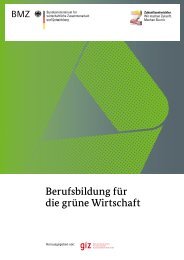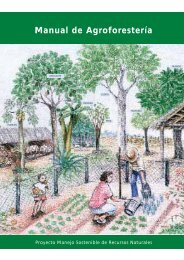SUMMARYIndeed, neem has been effective in animal husbandry where it has been applied in thetreatment of ectoparasites such as ticks.The main problems hindering greater acceptance of neem by farmers include poor disseminati<strong>on</strong>of neem-related knowledge and the fact that farmers have no access to neem eitheras raw material or ready-to use products. E.g. in those regi<strong>on</strong>s such as vegetable growingareas in which neem could be used successfully, there are not enough trees or n<strong>on</strong>e at all.Another important reas<strong>on</strong> is the lack of funds for the often small neem manufacturing companiesto invest in professi<strong>on</strong>al marketing and distributi<strong>on</strong> strategies.This document presents more than 120 projects, organisati<strong>on</strong>s, instituti<strong>on</strong>s and microindustriesand companies in 58 countries that are working <strong>on</strong> neem. The most importantactivities when working with neem in this c<strong>on</strong>text are to disseminate both the tree itself andknowledge of its potential uses, in particular as a n<strong>on</strong>-synthetic pesticide.India, Myanmar, Thailand, Kenya and the Dominican Republic are cited as examples of theway in which neem can be successfully propagated and used as a pesticide.Those areas suffering from erosi<strong>on</strong> could be reafforested with neem trees and given thetree’s many possible uses, villages could set up micro-industries which would help improvethe income situati<strong>on</strong> in rural areas. In additi<strong>on</strong> to using the seeds as a raw material for themanufacture of pesticides, soaps, fertilisers etc., the wood from the tree can be used for c<strong>on</strong>structi<strong>on</strong>and fuel and the leaves for medical, cosmetic and agricultural purposes.By referring to main references <strong>on</strong> neem, proceedings of c<strong>on</strong>ferences and workshops as wellas publicati<strong>on</strong>s of GTZ staff and the work c<strong>on</strong>ducted in a number of industrialised countries,the report then goes <strong>on</strong> to show just how vital and promising biological, n<strong>on</strong>-syntheticpesticides are for the future.5
1. INTRODUCTION1. Introducti<strong>on</strong>"The neem tree, the tree of the future" - this is more or less how all articles start when theIndian press features its neem tree. There is no doubt that the role this excepti<strong>on</strong>al tree withits manifold uses could play in securing food supply and protecting our envir<strong>on</strong>ment shouldnot be underestimated. The tree holds great potential for the reafforestati<strong>on</strong> of eroded soils,for use as a natural pesticide and in medicine - to name just a few of the most importantareas.The Deutsche Gesellschaft für Technische Zusammenarbeit (GTZ) GmbH started propagatingthe neem tree in development-cooperati<strong>on</strong> projects in the 70ies. Initially, the GTZ focused<strong>on</strong> researching its active principles and various possible uses, but later channelled its effortsinto disseminating the tree and knowledge of its practical uses, adressing first small farmersand ngo and later small scale entrepreneurs (7,8,16-19, 40). Today, the GTZ is workingtowards making this experience and knowledge available to broad secti<strong>on</strong>s of the populati<strong>on</strong>.To do so, work at project level al<strong>on</strong>e is not sufficient. Instead, neem usage has to beanchored <strong>on</strong> a broad basis in the populati<strong>on</strong> itself, a task requiring not <strong>on</strong>ly the commitmentof state-run programmes, which propagate the neem tree and its various uses, but <strong>on</strong>e whichalso relies <strong>on</strong> private organisati<strong>on</strong>s and the private sector. For <strong>on</strong>ly when a varied group ofsp<strong>on</strong>sors has come together will it be possible to integrate the neem tree sustainably andappropriately into the respective social setting.This study aims to document the current status of neem usage across the globe as well asthe experience gained to date, with a view to generating a basis for future neem projects.The key focus is <strong>on</strong> neem's use as a n<strong>on</strong>-synthetic pesticide; probably neem's greatestpotential beside medecin for use.In additi<strong>on</strong> to the informati<strong>on</strong> c<strong>on</strong>cerning neem's disseminati<strong>on</strong> and potential uses, this reportalso presents the key projects, organisati<strong>on</strong>s and instituti<strong>on</strong>s that work with neem or haveworked with it in the recent past. In so doing, the report looks into the various methods andtechnological approaches as well as the level of acceptance and the difficulties encounteredin using neem. Various countries' activities with neem are given as examples.To gain as complete an overview as possible of the current status of neem usage, fourdifferent methods were used to obtain the requisite informati<strong>on</strong>:1. Evaluati<strong>on</strong> of the latest literature and publicati<strong>on</strong>s <strong>on</strong> the subject of neem.2. Disseminati<strong>on</strong> of a questi<strong>on</strong>naire c<strong>on</strong>cerning global neem usage to GTZ projects andother organisati<strong>on</strong>s, as well as instituti<strong>on</strong>s or private people who work with neem; subsequentevaluati<strong>on</strong>.3. Compilati<strong>on</strong> and evaluati<strong>on</strong> of documents pertaining to projects that have just beencompleted, as well as evaluati<strong>on</strong> of documentati<strong>on</strong> <strong>on</strong> existing projects which did notreturn the questi<strong>on</strong>naire.4. Review of our backstopping and project planning activities during the past 5 years.Technical data <strong>on</strong> the questi<strong>on</strong>naire: 111 questi<strong>on</strong>naires were sent out in 1996 worldwide, 41to <strong>on</strong>going GTZ projects, 30 to GOs (instituti<strong>on</strong>s and projects), 34 to NGOs and 6 to privateindividuals. The resp<strong>on</strong>se rate totalled 42 %.6
- Page 2 and 3: iviDivision 45Rural DevelopmentWork
- Page 4 and 5: Table of ContentsPageForeword for t
- Page 6 and 7: FOREWORDForeword for the 2 nd Editi
- Page 10 and 11: 2. GLOBAL NEEM DISSEMINATION AND US
- Page 12 and 13: 2. GLOBAL NEEM DISSEMINATION AND US
- Page 14 and 15: 2. GLOBAL NEEM DISSEMINATION AND US
- Page 16 and 17: 2. GLOBAL NEEM DISSEMINATION AND US
- Page 18 and 19: 2. GLOBAL NEEM DISSEMINATION AND US
- Page 20 and 21: 2. GLOBAL NEEM DISSEMINATION AND US
- Page 22 and 23: 2. GLOBAL NEEM DISSEMINATION AND US
- Page 24 and 25: 2. GLOBAL NEEM DISSEMINATION AND US
- Page 26 and 27: 3. NEEM AS A NON-SYNTHETIC PESTICID
- Page 28 and 29: 3. NEEM AS A NON-SYNTHETIC PESTICID
- Page 30 and 31: 3. NEEM AS A NON-SYNTHETIC PESTICID
- Page 32 and 33: 3. NEEM AS A NON-SYNTHETIC PESTICID
- Page 34 and 35: 3. NEEM AS A NON-SYNTHETIC PESTICID
- Page 36 and 37: 3. NEEM AS A NON-SYNTHETIC PESTICID
- Page 38 and 39: 3. NEEM AS A NON-SYNTHETIC PESTICID
- Page 40 and 41: 3. NEEM AS A NON-SYNTHETIC PESTICID
- Page 42 and 43: 3. NEEM AS A NON-SYNTHETIC PESTICID
- Page 44 and 45: 3. NEEM AS A NON-SYNTHETIC PESTICID
- Page 46 and 47: 3. NEEM AS A NON-SYNTHETIC PESTICID
- Page 48 and 49: 4. NEEM IN DEVELOPMENT-COOPERATION
- Page 50 and 51: 4. NEEM IN DEVELOPMENT-COOPERATION
- Page 52 and 53: 4. NEEM IN DEVELOPMENT-COOPERATION
- Page 54 and 55: 4. NEEM IN DEVELOPMENT-COOPERATION
- Page 56 and 57: 4. NEEM IN DEVELOPMENT-COOPERATION
- Page 58 and 59:
4. NEEM IN DEVELOPMENT-COOPERATION
- Page 60 and 61:
4. NEEM IN DEVELOPMENT-COOPERATION
- Page 62 and 63:
4. NEEM IN DEVELOPMENT-COOPERATION
- Page 64 and 65:
4. NEEM IN DEVELOPMENT-COOPERATION
- Page 66 and 67:
4. NEEM IN DEVELOPMENT-COOPERATION
- Page 68 and 69:
4. NEEM IN DEVELOPMENT-COOPERATION
- Page 70 and 71:
4. NEEM IN DEVELOPMENT-COOPERATION
- Page 72 and 73:
4. NEEM IN DEVELOPMENT-COOPERATION
- Page 74 and 75:
4. NEEM IN DEVELOPMENT-COOPERATION
- Page 76 and 77:
4. NEEM IN DEVELOPMENT-COOPERATION
- Page 78 and 79:
4. NEEM IN DEVELOPMENT-COOPERATION
- Page 80 and 81:
4. NEEM IN DEVELOPMENT-COOPERATION
- Page 82 and 83:
4. NEEM IN DEVELOPMENT-COOPERATION
- Page 84 and 85:
4. NEEM IN DEVELOPMENT-COOPERATION
- Page 86 and 87:
4. NEEM IN DEVELOPMENT-COOPERATION
- Page 88 and 89:
4. NEEM IN DEVELOPMENT-COOPERATION
- Page 90 and 91:
4. NEEM IN DEVELOPMENT-COOPERATION
- Page 92 and 93:
4. NEEM IN DEVELOPMENT-COOPERATION
- Page 94 and 95:
4. NEEM IN DEVELOPMENT-COOPERATION
- Page 96 and 97:
4. NEEM IN DEVELOPMENT-COOPERATION
- Page 98 and 99:
4. NEEM IN DEVELOPMENT-COOPERATION
- Page 100 and 101:
4. NEEM IN DEVELOPMENT-COOPERATION
- Page 102 and 103:
5. PROSPECTS AND POSSIBILITIES FOR
- Page 104 and 105:
6. OUTLOOK6. OutlookIn many develop
- Page 106 and 107:
ANNEXAnnex103
- Page 108 and 109:
ANNEX14 OSTERMANN, H.: Zur Wirtscha
- Page 110 and 111:
ANNEX41 GRUNEWALD, J. & A. VOLLMER
- Page 112 and 113:
ANNEXGERRITS, R., VAN LATUM, E., (1
- Page 114 and 115:
ANNEXList of addresses of those org
- Page 116 and 117:
ANNEX- Coopération de Soyo, Martin
- Page 118 and 119:
ANNEXList of Publications on Neem o
- Page 120 and 121:
ANNEXHELLPAP, C. & DREYER, M. (1995
- Page 122 and 123:
ANNEXInternational Institute of Tro
- Page 124 and 125:
ANNEXSOMBATSIRI, K., ERMEL, K. & SC
















